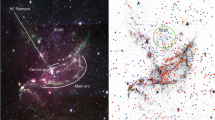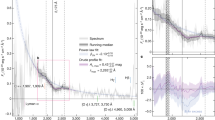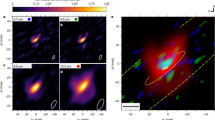Abstract
The origin of the radiation observed in the region of the supernova remnant RX J1713.7−3946, one of the brightest TeV emitters, has been debated since its discovery. The existence of atomic and molecular clouds in this object supports the idea that part of the GeV gamma-ray emission in this region originates from proton–proton collisions. However, the observed column density of protons derived from observations of the gas cannot explain the whole emission. Yet there could be a fraction of protons contained in fainter structures that have not been detected so far. Here we search for faint objects in the line of sight of RX J1713.7−3946 using the principle of light extinction and the European Space Agency’s Gaia mission Data Release 2 astrometric and photometric data. We reveal and locate with precision a number of dust clouds and note that only one appears to be in the vicinity of RX J1713.7−3946. We estimate the embedded mass to be Mdust = (7.0 ± 0.6) × 103 M⊙, which might be big enough to contain the missing protons. Finally, using the fact that the supernova remnant is expected to be located in a dusty environment and that there appears to be only one such structure in the vicinity of RX J1713.7−3946, we set a very precise constraint on the supernova remnant distance, at 1.12 ± 0.01 kpc.
This is a preview of subscription content, access via your institution
Access options
Access Nature and 54 other Nature Portfolio journals
Get Nature+, our best-value online-access subscription
$29.99 / 30 days
cancel any time
Subscribe to this journal
Receive 12 digital issues and online access to articles
$119.00 per year
only $9.92 per issue
Buy this article
- Purchase on Springer Link
- Instant access to full article PDF
Prices may be subject to local taxes which are calculated during checkout




Similar content being viewed by others
Data availability
The data used for our reconstruction are available from ref. 24. The results of our reconstruction is available at https://doi.org/10.5281/zenodo.4462826. The dataset consists of six approximate posterior samples over the whole reconstruction volume in Cartesian coordinates.
References
Aharonian, F. A. Gamma rays from supernova remnants. Astropart. Phys. 43, 71–80 (2013).
Aharonian, F., Ruizhi, Y. & de Oña Wilhelmi, E. Massive stars as major factories of Galactic cosmic rays. Nat. Astron. 3, 561–567 (2019).
Abdalla, H. et al. H.E.S.S. observations of RX J1713.7−3946 with improved angular and spectral resolution: evidence for gamma-ray emission extending beyond the X-ray emitting shell. Astron. Astrophys. 612, A6 (2018).
Slane, P. et al. Non-thermal X-ray emission from the shell-type supernova remnant G347.3−0.5. Astrophys. J. 525, 357 (1999).
Sano, H. et al. A detailed study of non-thermal X-ray properties and Interstellar gas toward the γ-ray supernova remnant RX J1713.7−3946. Astrophys. J. 729, 175 (2015).
Lazendic, J. S. et al. A high-resolution study of non-thermal radio and X-ray emission from supernova remnant G347.3−0.5. Astrophys. J. 602.1, 271 (2004).
Abdo, A. A. et al. Observations of the young supernova remnant RX J1713.7−3946 with the Fermi Large Area Telescope. Astrophys. J. 734, 28 (2011).
Gabici, S. & Aharonian, F. Gamma-ray emission from young supernova remnants: hadronic or leptonic? EPJ Web Conf. 121, 04001 (2015).
Yamazaki, R., Kohri, K. & Katagiri, H. Gamma-ray spectrum of RX J1713.7−3946 in the Fermi era and future detection of neutrinos. Astron. Astrophys. 495, 9–13 (2009).
Gabici, S. & Aharonian, F. Hadronic gamma-rays from RX J1713.7−3946? Mon. Not. R. Astron. Soc. 445, L70–L73 (2014).
Celli, S., Morlino, G., Gabici, S. & Aharonian, F. Supernova remnants in clumpy media: particle propagation and gamma-ray emission. Mon. Not. R. Astron. Soc. 487, 3199–3213 (2019).
Fukui, Y. et al. A detailed study of the molecular and atomic gas toward the γ-ray supernova remnant RX J1713.7−3946: spatial TeV γ-ray and interstellar medium gas correspondence. Astrophys. J. 746, 82 (2012).
Inoue, T., Yamazaki, R., Inutsuka, S. & Fukui, Y. Toward understanding the cosmic-ray acceleration at young supernova remnants interacting with interstellar clouds: possible applications to RX J1713.7−3946. Astrophys. J. 744, 71 (2012).
Ambrogi, L., Celli, S. & Aharonian, F. On the potential of Cherenkov Telescope Arrays and KM3 Neutrino Telescopes for the detection of extended sources. Astropart. Phys. 100, 69–79 (2018).
Adrian-Martínez, S. et al. Letter of intent for KM3NeT 2.0. J. Phys. G 43, 084001 (2016).
The Cherenkov Telescope Array Consortium Science with the Cherenkov Telescope Array (World Scientific, 2018).
Fukui, J. et al. Discovery of interacting molecular gas toward the TeV gamma-ray peak of the SNR G 347.3−0.5. Publ. Astron. Soc. Jpn. 55, L61–L64 (2003).
Sano, H. et al. Star-forming dense cloud cores in the TeV gamma-ray SNR RX J1713.7−3946. Astrophys. J. 724, 59 (2010).
Sano, H. et al. Non-thermal X-rays and interstellar gas toward the γ-ray supernova remnant RX J1713.7−3946: evidence for X-ray enhancement around CO and H i clumps. Astrophys. J. 778, 59 (2013).
Moriguchi, Y. et al. A detailed study of molecular clouds toward the TeV gamma-ray supernova remnant G347.3−0.5. Astrophys. J. 631, 947–963 (2005).
Maxted, N. et al. Dense gas towards the RX J1713.7−3946 supernova remnant. Publ. Astron. Soc. Aust. 30, 1–14 (2013).
Uchiyama, Y., Aharonian, F. A., Tanaka, T., Takahashi, T. & Maeda, Y. Extremely fast acceleration of cosmic rays in a supernova remnant. Nature 449, 576–578 (2007).
Dobashi, K. et al. Atlas and catalog of dark clouds based on Digitized Sky Survey I. Publ. Astron. Soc. Jpn 57, S1–S386 (2005).
Anders, F. et al. Photo-astrometric distances, extinctions, and astrophysical parameters for Gaia DR2 stars brighter than G = 18. Astron. Astrophys. 628, A94 (2019).
Gaia Collaboration Gaia Data Release 2. Summary of the contents and survey properties. Astron. Astrophys. 616, A1 (2018).
Lindegren, L. et al. Gaia Data Release 2. The astrometric solution. Astron. Astrophys. 616, A2 (2018).
Skrutskie, M. F. et al. The Two Micron All Sky Survey (2MASS). Astron. J. 131, 1163 (2006).
Kaiser, N. et al. Pan-STARRS: a large synoptic survey telescope array. Survey and other telescope technologies and discoveries. Proc. SPIE 4836, 154–164 (2002).
Cutri, R. M. et al. AllWISE Data Release: II/328 (VizieR, 2013); https://cdsarc.unistra.fr/viz-bin/cat/II/328
Brand, J. & Blitz, L. The velocity field of the outer galaxy. Astron. Astrophys 275, 67–90 (1993).
Gaia Collaboration The Gaia mission. Astron. Astrophys. 595, A1 (2016).
Leike, R. L., Glatzle, M. & Enßlin, T. A. Resolving nearby dust clouds. Astron. Astrophys. 639, A138 (2020).
Green, D. A. Galactic SNRs: Summary Data (2019); http://www.mrao.cam.ac.uk/surveys/snrs/snrs.data.html
Micelotta, E. R., Matsuura, M. & Sarangi, A. Dust in supernovae and supernova remnants II: processing and survival. Space Sci. Rev. 214, 53 (2018).
Voshchinnikov, N. V., Henning, T. & Il’in, V. B. Mid-infrared extinction and fresh silicate dust toward the Galactic Center. Astrophys. J. 837, 25 (2017).
Draine, B. T. Interstellar dust grains. Annu. Rev. Astron. Astrophys. 41, 241–289 (2003).
Xue, M. et al. A precise determination of the mid-infrared interstellar extinction law based on the APOGEE spectroscopic survey. Astrophys. J. Suppl. Ser. 224, 23 (2016).
Wang, S. & Xiaodian, C. The optical to mid-infrared extinction law based on the APOGEE, Gaia DR2, Pan-STARRS1, SDSS, APASS, 2MASS, and WISE surveys. Astrophys. J. 877, 116 (2019).
The Planck Collaboration Planck 2018 results-I. Overview and the cosmological legacy of Planck. Astron. Astrophys. 641, A1 (2020).
Leike, R. & Enßlin, T. Charting nearby dust clouds using Gaia data only. Astron. Astrophys. 631, A32 (2019).
Knollmüller, J. & Enßlin, T. Metric Gaussian variational inference. Preprint at https://arxiv.org/abs/1901.11033 (2019).
Foight, D. R., Güver, T., Özel, F. & Slane, P. O. Probing X-ray absorption and optical extinction in the interstellar medium using Chandra observations of supernova remnants. Astrophys. J. 826, 66 (2016).
Goodman, A. A., Pineda, J. E. & Schnee, S. L. The "true" column density distribution in star-forming molecular clouds. Astrophys. J. 692, 91 (2009).
Acknowledgements
This research has made use of public data from the HESS telescope https://www.mpi-hd.mpg.de/hfm/HESS/pages/dl3-dr1/. We gratefully acknowledge the NANTEN team, for sharing gas data in our region of interest. A.K.-M. acknowledges the support from the Fundação para a Ciência e a Tecnologia (FCT) through grants PTDC/FIS-AST/31546/2017 and UID/FIS/00099/2013. This work has made use of data from the ESA mission Gaia (https://www.cosmos.esa.int/gaia), processed by the Gaia Data Processing and Analysis Consortium (DPAC, https://www.cosmos.esa.int/web/gaia/dpac/consortium). Funding for the DPAC has been provided by national institutions, in particular the institutions participating in the Gaia Multilateral Agreement. A.K.-M. is a member of the Gaia DPAC.
Author information
Authors and Affiliations
Contributions
The idea was proposed by C.B. and developed with S.C. and A.K.-M. R.L. developed and applied the entire method, wrote the Methods section and contributed to the text of the manuscript. S.C. wrote large parts of the manuscript and helped to review and understand the results of the method. A.K.-M. and C.B. wrote substantial parts of the manuscript and helped to review and understand the results of the method. M.G. provided code and numerical advice regarding the method and helped to review the manuscript. Y.F. and H.S. contributed ISM data and helped to review the manuscript. G.R. contributed to the data and helped to review the manuscript and understand the results.
Corresponding authors
Ethics declarations
Competing interests
The authors declare no competing interests.
Additional information
Peer review information Nature Astronomy thanks Fabio Acero and Naomi Tsuji for their contribution to the peer review of this work.
Publisher’s note Springer Nature remains neutral with regard to jurisdictional claims in published maps and institutional affiliations.
Supplementary information
Supplementary Information
Supplementary Fig. 1.
Rights and permissions
About this article
Cite this article
Leike, R., Celli, S., Krone-Martins, A. et al. Optical reconstruction of dust in the region of supernova remnant RX J1713.7−3946 from astrometric data. Nat Astron 5, 832–838 (2021). https://doi.org/10.1038/s41550-021-01344-w
Received:
Accepted:
Published:
Issue Date:
DOI: https://doi.org/10.1038/s41550-021-01344-w



